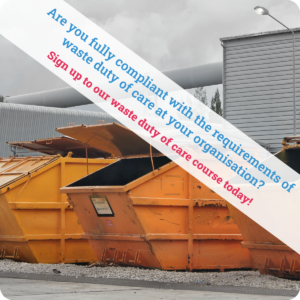Changes are coming to waste exemptions in England & Wales.
If you currently operate a waste activity under an exemption, you’ll need to understand how these changes will affect you, and importantly – how to prepare.
In short, some operators will need to get an environmental permit, change their activities, or stop them completely.
Consultant Rayan Stanislaus from The Compliance People gives you a summary of what to expect.
Firstly, why is it changing?
Currently, the Waste Exemption Regime allows some low-risk activities to be carried out on a registration system and be exempt from the requirement to hold an environmental permit. This Regime is set out within The Environmental Permitting (England and Wales) Regulations 2016 (EPR).
What are the changes?
The general changes to the Waste Exemption Regime are as follows.
- The use of exemptions at/adjacent to permitted sites will be prohibited.
- Waste exemptions will not be able to be registered at sites with a direct link* to an installation or permitted waste site.
- S1 and S2 exemptions will be prohibited from being registered at a site where there is a direct link to any other waste exemption.
- Operators must keep general electronic records relating to waste exemption activities.
*Direct link means where an exempted waste activity:
- is carried out on adjacent to a permitted waste operation; and
- is carried out under the control of the same operator; or
- uses the same staff, equipment, or infrastructure as used in an exempted waste activity
Waste exemptions to be removed
The following waste exemptions will be removed, and operators will need to carry out activities under an environmental permit or stop the activities completely. The transition period for these changes is 3 months.
- T8 – Mechanically treating end-of-life tires.
- T9 – Recovering scrap metal.
- U16 – Use of depolluted ELV for parts.
Changes to specific waste exemption conditions
Specific waste exemptions will have their conditions changed. There will be a transitional period for each of these waste exemptions after the EPR changes come into effect, giving operators time to adjust. Within these periods, you must make changes to your activities to ensure compliance, apply for the appropriate permit, or stop the waste activity.
Detailed information on all the changes is published in Defra’s supplementary Government response and annexes.
The tables below give a summary of the changes to specific waste exemptions and transition periods (it may worthwhile saving it, as it will come in handy later).
| Exemptions | Condition changes | Transition period |
| U1 – Use of waste in construction |
|
12 months |
| T4 – Preparatory treatments, such as, baling, sorting, shredding |
|
6 months |
| T6 – Treating waste woods and waste plant matter by chipping, shredding, cutting, or pulverising |
|
6 months |
| T12 – Manually treating waste |
|
6 months |
| D7 – Burning waste in the open |
|
6 months |
|
|
|
12 months
|
Next steps
It is best to review your registered waste exemption(s) against the Government’s guidance. You can find details of your current waste exemption(s) on the Government’s public register. The Environment Act 2021 gives regulators powers to amend certain exemption conditions without amending legislation, so we can expect future changes to the Waste Exemption Regime.
In the meantime, we will keep you updated on everything you need to know about the changes to waste exemptions. If you’re struggling to wrap your head around these changes, our consultants are happy to support you to ensure your organisation remains compliant with all environmental permitting requirements.
Find out how our Legal Registers work
No obligation demo to help you understand how it works and how your business can use it
